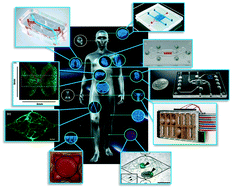Our official English website, www.x-mol.net, welcomes your feedback! (Note: you will need to create a separate account there.)
Tissue chips – innovative tools for drug development and disease modeling
Lab on a Chip ( IF 6.1 ) Pub Date : 2017-08-10 00:00:00 , DOI: 10.1039/c7lc00462a L. A. Low 1, 2, 3, 4 , D. A. Tagle 1, 2, 3, 4
Lab on a Chip ( IF 6.1 ) Pub Date : 2017-08-10 00:00:00 , DOI: 10.1039/c7lc00462a L. A. Low 1, 2, 3, 4 , D. A. Tagle 1, 2, 3, 4
Affiliation

|
The high rate of failure during drug development is well-known, however recent advances in tissue engineering and microfabrication have contributed to the development of microphysiological systems (MPS), or ‘organs-on-chips’ that recapitulate the function of human organs. These ‘tissue chips’ could be utilized for drug screening and safety testing to potentially transform the early stages of the drug development process. They can also be used to model disease states, providing new tools for the understanding of disease mechanisms and pathologies, and assessing effectiveness of new therapies. In the future, they could be used to test new treatments and therapeutics in populations – via clinical trials-on-chips – and individuals, paving the way for precision medicine. Here we will discuss the wide-ranging and promising future of tissue chips, as well as challenges facing their development.
中文翻译:

组织芯片–用于药物开发和疾病建模的创新工具
药物开发过程中的高失败率是众所周知的,但是组织工程和微细加工的最新进展促进了微生理系统(MPS)或概括器官功能的“芯片上的器官”的发展。这些“组织芯片”可用于药物筛选和安全性测试,以潜在地改变药物开发过程的早期阶段。它们还可以用于建模疾病状态,提供新的工具来理解疾病的机制和病理,并评估新疗法的有效性。将来,它们可用于通过以下途径测试人群中的新疗法和疗法:芯片上的临床试验–以及个人,为精密医学铺平了道路。在这里,我们将讨论卫生纸芯片的广阔前景,以及其发展所面临的挑战。
更新日期:2017-09-12
中文翻译:

组织芯片–用于药物开发和疾病建模的创新工具
药物开发过程中的高失败率是众所周知的,但是组织工程和微细加工的最新进展促进了微生理系统(MPS)或概括器官功能的“芯片上的器官”的发展。这些“组织芯片”可用于药物筛选和安全性测试,以潜在地改变药物开发过程的早期阶段。它们还可以用于建模疾病状态,提供新的工具来理解疾病的机制和病理,并评估新疗法的有效性。将来,它们可用于通过以下途径测试人群中的新疗法和疗法:芯片上的临床试验–以及个人,为精密医学铺平了道路。在这里,我们将讨论卫生纸芯片的广阔前景,以及其发展所面临的挑战。



























 京公网安备 11010802027423号
京公网安备 11010802027423号